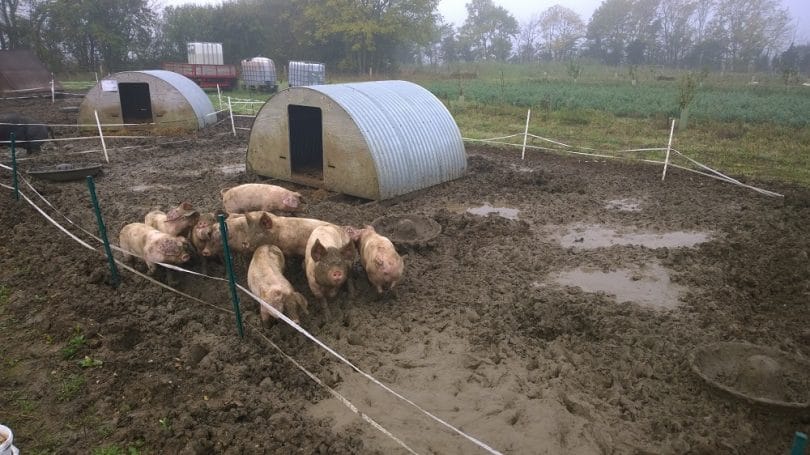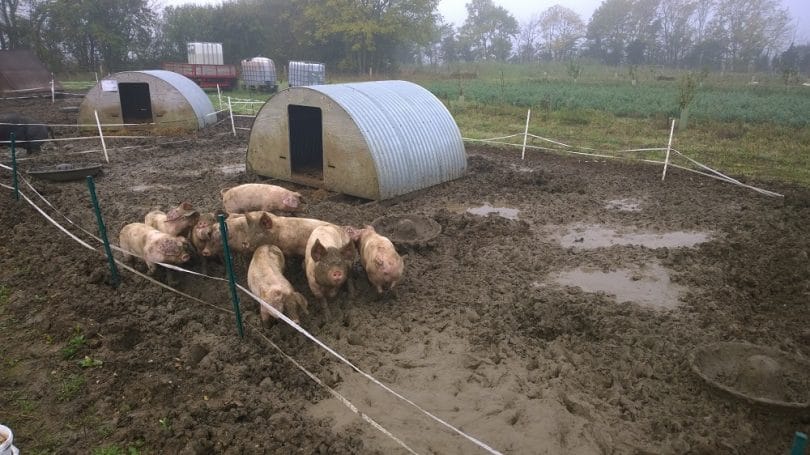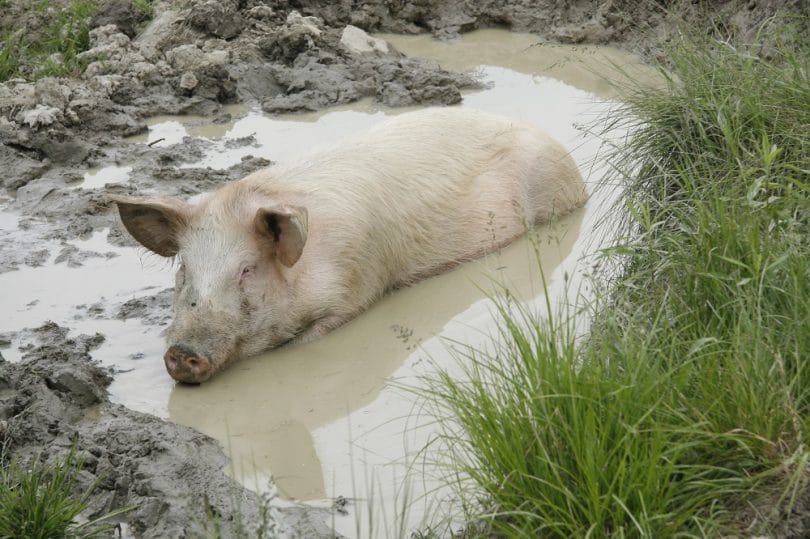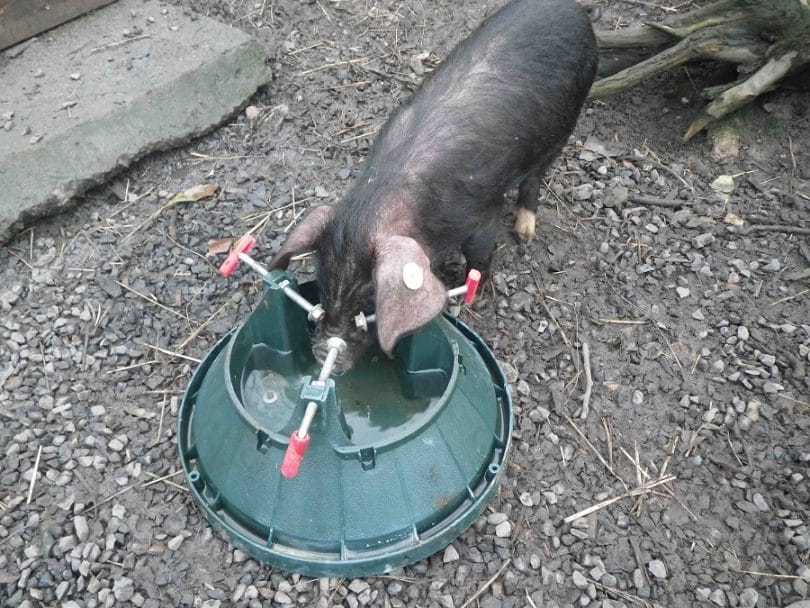Unlike chickens, which are another common farm animal, pigs are larger and can be potentially more demanding in terms of care. However, because you’ve chosen a rural life, you’ll have plenty of space and resources to give your pigs the essentials that they’ll need to remain healthy. The information below is your guide to raising pigs and covers everything from shelter to food to purchasing piglets.
PIG HOUSING
Pigs require a shelter that is warm and dry and some protective covering when there are adverse weather conditions. The shelter you provide your pigs with, needs to be spacious enough to give the animals free room to roam and move around without overcrowding.
Consider the following as you prepare and ready a shelter for your animals:
If you already have a barn for the pigs, you are ahead of the game.
- If you have a barn, you can establish a pen around the barn door opening: Doing so will allow you to establish plenty of run space for your pigs.
- An adult pig needs a minimum of 50 square feet of free space to move around in.
- Draw up a plan for the pen. When doing so, map out a pen that is two times longer than its width.
- When staging the pen for the pigs, position the food source and the pig’s shelter at one end, and the pigs’ supply of water at the other: You must do this because pigs will often urinate and defecate nearby the source of water.
- To keep your pigs both caged and safe from would-be-predators, you need to put up a wired fence around the enclosure. A board has to run along the bottom of the fence work; it makes the area hog tight and stops the pigs or predators from digging underneath.
SECURE PIG HOUSING
At the bare minimum, you need to put some additional wire around your pig pen enclosure. If you are building your fence from scratch, you can implement the following measures to ensure the security of the enclosure:
To prevent the escape of pigs, build a fence out of solid wood and enclose the pig area.
To stop your pigs from pushing up against the wooden fence you build and forcing their way through it, add a 4×2 welded wire to the fence’s interior.
If you allow your pigs to roam free in a pasture, a stationary or moveable electric fence might prove ideal.
Do not try to cut corners by not providing your pigs with at least some kind of shelter. Pigs, if exposed to the sun for long periods of time, can get sunburn. If the weather is cold the pigs will desire shelter from the wind and cold air.
At a minimum, a partial shelter is needed and most farmers recommend a minimum of 15 to 20 square feet of space to provide your pigs with the proper shade and covering. Consider the following features:
When erecting a partial shelter the covering has three sides and one wide-open entry. You can position the shelter in one of the corners of your pigpen enclosure.
The roof should be a minimum of four feet high for ample space.
Under the eaves, you should leave an opening for the escape of excess heat in the late spring and summer months.
During the warmer months, securing a shade cloth to the enclosure helps cool the area.
During winter months, a bedding of hay helps to insulate the shelter so your pigs can remain warm.
PIG MUD WALLOW
Your pigs will need to wallow in some mud as it helps them to keep their body temperature regulated. The ability to cool down and to find relief from the stress extremes in heat impose lets your pigs be comfortable, but it helps in preventing heat related or induced heart attacks.
In the event you feel you do not have enough space in the pen for a wallow, you can do one of two things: Extend your enclosure or use a kiddies’ pool as an area where your pigs can cool down.
Here’s how:
Decide where in the pen you will place the mud wallow. You will have to section the area off from the remainder of the pen.
Add low-height fencing to section of the area. As an alternative, you can dig a trough around the space you are sectioning off.
The soil needs to be loose so you will have to till the mud wallow area.
Once the mud wallow has been tilled, add sufficient water.
Monitor the water level of the mud wallow. If more water is needed, add some. A daily check on the water levels is recommended.
To ensure the integrity of the wallow and to limit the accumulation of flies, refrain from getting pig food (scraps or feed) in the wallow. By keeping the food out of the wallow, you are helping to reduce the flies attracted to the area.
The Benefits Of Raising Pigs
Characteristics to look for in a piglet
- A weaned pig that can eat on its own
- Strong
- Active
- Big shoulders
- Big Hips
- Lean body structure
What to avoid
- Fatigued Looking
- Listless
- Non-active
- Excessively thin
- Malformed
- Born with a defect
The most-ideal time to buy pigs is when the weather is warm because pigs thrive best in a warm environment. You will want to buy the feed you need in advance. Over the course of 100 days, a 50 pound piglet can more than quadruple in size and grow into a 250 pound adult pig.
FEED AND WATER
You can make your own feed, which can prove expensive, but it is far easier to buy feed from the local feed store. When you invest in a feed that is already pre-mixed you can ensure that the pigs are getting a balanced diet with all the nutrients they need to grow strong and healthy.
When feeding a 50 pound pig it will need a feed that contains at least 16 percent protein. As the pig ages, its need for protein declines: a 125 pound pig will only require all of 14 percent protein.
Things that are toxic for pigs
- Toxic plants
- Salt
- Rat poison and warfarin
- Gasses: Hydrogen sulfide, carbon monoxide, and ammonia.
- Minerals: Zinc, selenium, manganese, iron, iodine, and copper
- Trace elements: Coal tars, fluorine, lead, mercury, arsenic, selenium, iodine, zinc, copper, and iron.
- Anti-bacterial: Sulphadimidine, monensin, furazolidone, and cabadox
A pig can consume two to four gallons of fresh water daily. Invest in a tub and fill it, but also check it with some frequency to ensure the water is fresh, clean, un-evaporated and not spilled.
KEEPING A CLEAN STY
The best use for the manure is for any landscaping you will be doing. Add the manure to shrub bases, tree bases, and flower beds to promote the healthy growth. If you are going to use pig manure there are some things to consider before adding it to any area where you will be growing food. The manure contains bacteria that can transfer to your foods.
Make sure you clean the foods thoroughly before consumption. Additionally, the manure is also low in nitrogen. You will therefore have to add more to make the most out of the manure you decide to use.
One final note on cleaning the pig pen enclosure: with manure you have flies, and pigs will also leave urine spots nearby their source of water. You will need to cover up the spots with a bit of garden lime to keep flies away.
SAVING MONEY ON FEED COSTS
As long as the food scraps are edible and mold free, you can add it to your pig’s diet. Use a container to add scraps into it after finishing a meal or cleaning the refrigerator, and then serve the scraps with the pigs’ regular feeding.
YOU BENEFIT FROM HAVING MORE THAN ONE PIG
Some pig sellers will only sell two at a time or more because pigs are social animals. It improves the mental and emotional health of the animals, and they thrive better.
Do you have any other tips for raising pigs?
Article and Photo Source: Survival Mastery




Looks like it smells real sweet there….P U